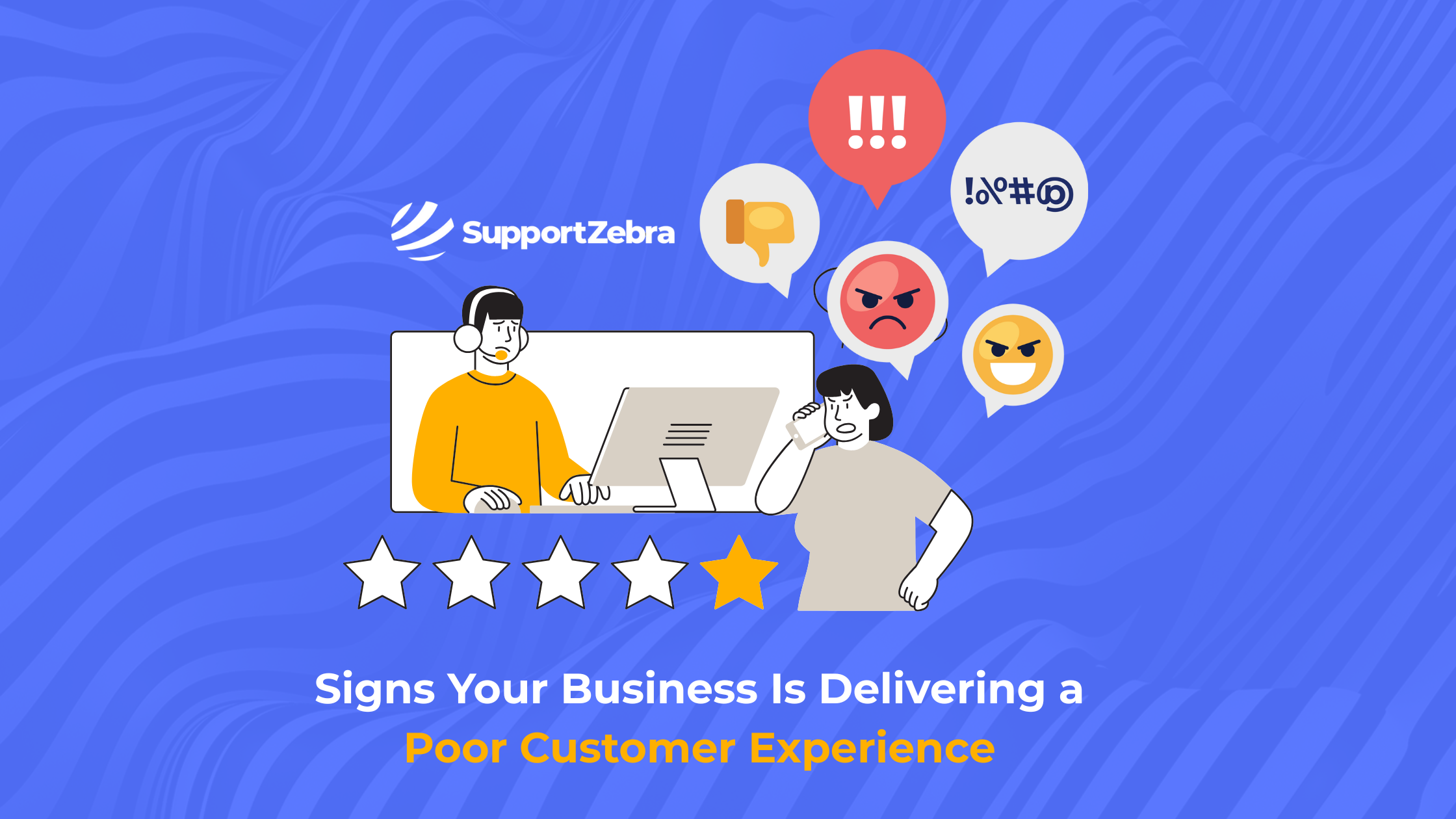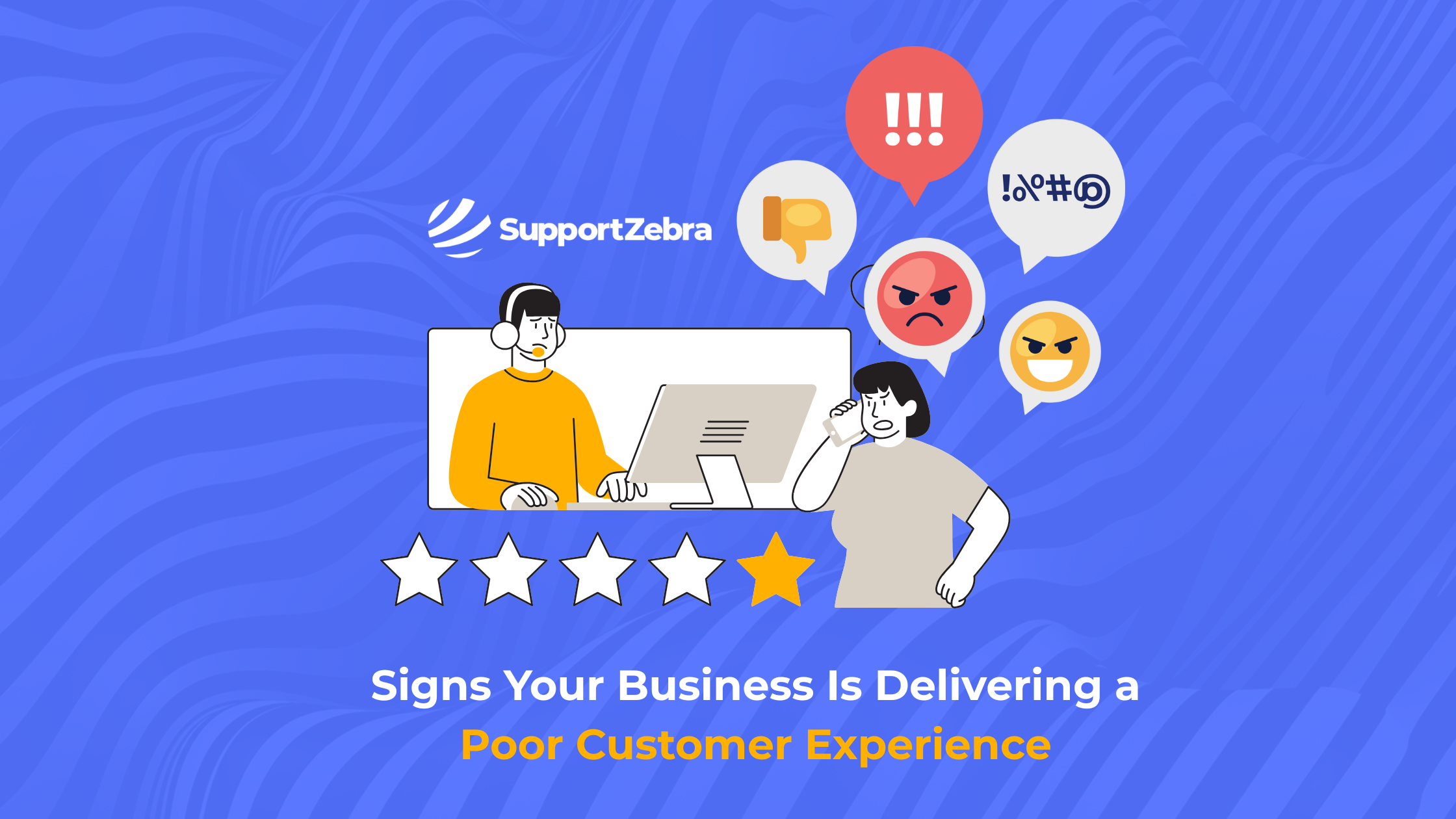Warning Signs of a Poor Customer Experience
Key Takeaways:
- Poor customer experiences often show up in subtle ways, like slower repeat visits, quiet churn, or low staff morale, that can easily go unnoticed.
- Long wait times, inconsistent communication, and a lack of empathy from frontline staff are major red flags driving customers away.
- Outdated tools and unmeasured performance weaken your service, while unresolved complaints and bad reviews damage your brand reputation.
- With the right support partner like SupportZebra, businesses can identify experience gaps, rebuild trust, and turn frustrated customers into loyal ones.
If your customers are going quiet, leaving bad reviews, or simply not coming back, you’re not alone, and it’s not always easy to spot the problem from the inside. Poor customer experience often hides in plain sight, showing up in subtle ways that can cost you loyalty, revenue, and reputation. It’s frustrating, especially when you’re putting in the work but still losing ground. Left unchecked, these issues can snowball into long-term damage that’s much harder to fix.
The good news? You don’t have to figure it out alone. With the right support, you can identify the cracks, rebuild trust, and turn unhappy customers into loyal ones again.
What Are the Early Red Flags That Customer Experience Is Suffering?
When customers start leaving negative reviews, reducing repeat visits, or simply dropping off without feedback, your service might be broken. Multiple complaints—even one or two—warrant attention; unhappy customers are far more likely to speak up than satisfied ones. Signs include:
- A rise in negative online ratings or public mentions
- Drop in repeat customer rate
- A shrinking referral base
Catching these early helps your business avoid long-term brand damage, since unhappy customers spread news far faster than satisfied ones.
How Do Long Wait Times and Slow Responses Reveal Poor Customer Experience?
Unacceptable wait and resolution times irritate customers quickly. For example, in retail, long queues are cited as the top frustration—51% of shoppers abandon purchases due to slow service. In contact centers, delays beyond 4 hours can alienate nearly half of the customers. Key symptoms include:
- Customers stuck in long queues (phone or in-person)
- No callback options or misleading wait time estimates
Delays in resolving simple issues
To fix this, streamline workflows, introduce intelligent chatbots, callback systems, and ensure sufficient staff during peak hours.
Can a Lack of Empathy From Frontline Staff Harm Customer Experience?
Yes—customers who feel they’re treated as inconveniences, rather than valued individuals, leave frustrated and disloyal. Lack of empathy and rude communication are the top causes of negative experiences. Red flag behaviors include:
- Agents using dismissive or scripted responses
- No acknowledgment of customer emotions or concerns
- Lack of personalized language in support interactions
Training in active listening and emotional intelligence helps staff display genuine care, which in turn increases trust and retention.
How Does Confusing or Inconsistent Communication Impact CX?

If customers feel lost or misunderstood during support, it erodes trust and drives them away. Examples include repetitive transfers, jargon-filled replies, or conflicting messages. Look out for:
- Customers repeatedly telling their story to multiple agents
- Use of technical, complex terms that customers don’t understand
- Contradictory information from different departments
Streamline information flow with unified support platforms (CRM), standard messaging protocols, and train staff to speak clearly and consistently.
Why Do Outdated Tools and Tech Shortcuts Lead to Bad Experiences?
Customers expect convenience. When your self‑service FAQs are outdated, your site navigation is clunky, or chatbots are ineffective, frustration sets in. Symptoms include:
- Difficulty locating help in your knowledge base
- Old or broken site structure or outdated support content
- Chatbots that transfer customers to live agents prematurely
Invest in multi-format support content (videos, articles, guides), keep help docs updated, and use chatbots to handle simple queries while escalating complex cases smoothly.
What Is the Effect of High Customer Churn and Negative Word‑of‑Mouth?
Losing customers is financially painful. Research shows that one single bad interaction can prompt a customer to leave, and 86% of them will abandon a brand after just two poor experiences. Consequences are:
- Declining sales and reduced Customer Lifetime Value
- Increasing cost to acquire new customers versus retaining old ones
- Negative online buzz that deters potential buyers
Monitor churn metrics and referral rates regularly. Use feedback loops to identify at-risk customers and re-engage them before it’s too late.
How Can a Bad Reputation Online Indicate a Deeper Issue?
Even a handful of bad reviews can damage your reputation quickly—people tend to share negative experiences more aggressively than positive ones. Watch out for:
- A sudden spike in critical complaints or social media posts
- Recurring themes in reviews (e.g., rude staff, delays)
- Low Net Promoter Score trends
Actively solicit reviews, respond promptly to feedback (public and private), and turn negative reviews into positive brand opportunities by demonstrating accountability.
How Does Poor Staff Morale Tie Into Poor Customer Experience?
Unengaged or unhappy employees often deliver disappointing service. Employees lacking motivation or information produce more errors, slower responses, and less empathy. Indicators include:
- High employee turnover in support departments
- Negative employee surveys or low internal satisfaction scores
- Staff lacking knowledge or resources during customer interactions
Improve employee experience by offering regular training, access to helpful tools, and recognizing good service. Empowered teams are more engaged and serve customers better.
What’s the Downside of Viewing Customer Service as a Cost, Not Marketing?
When you see support simply as a department expense, you miss its power to drive brand reputation and revenue. Customer service becomes just a reaction, not a retention or promotional channel. Consequences:
- Lost opportunity for word-of-mouth referrals
- Missing data insights from customer interactions
- Focusing only on new customer acquisition, not retention
Reframe support as a strategic asset. Empower staff, create upsell/customer advocacy programs, and integrate service metrics into your marketing KPIs.
How Do Customers React When Complaints Go Unanswered?
Silence after a complaint is worse than a direct no. Only about 4 % of unhappy customers voice their concerns, meaning silent churn is rampant. Signs of this include:
- Lack of follow-up after complaint submission
- No visible feedback mechanism or callback system
- A drop in satisfaction, but no direct complaints
Proactively reach out after issues are raised, ask for feedback even when everything seems fine, and show empathy by acknowledging concerns, even when solutions aren’t immediate.
Why Is Measuring CX With the Right Metrics Essential?
Without data, you’re flying blind. Important metrics include:
- Average handle time vs. resolution time
- Customer Satisfaction (CSAT), Net Promoter Score (NPS) trends
- Churn rates, repeat purchase rates, and referral quantities
Track multiple KPIs regularly and correlate them with customer feedback. Use dashboards that combine support tickets, revenue, satisfaction, and employee insights for a complete picture.
Let’s Help You Deliver Service That Keeps Customers Coming Back

Poor customer experience isn’t usually caused by one catastrophic failure, but by the accumulation of minor issues. Slow responses, lack of empathy, outdated tech, miscommunication, low morale, and unmeasured performance can all combine to weaken your business reputation, customer loyalty, and bottom line.
By treating every customer interaction as an opportunity, investing in empathy training, updating your tech stack, and tracking key performance indicators, you can pivot from a declining experience to one that builds brand equity and drives growth. Start with a CX audit—review your most recent tickets, survey employees, and analyze where the friction is. Minor improvements here add up to big wins.
SupportZebra makes it easy. From 24/7 support to customer-first strategies, we help you uncover blind spots, strengthen service, and keep your customers loyal. Let’s transform your CX; talk to our team today.

